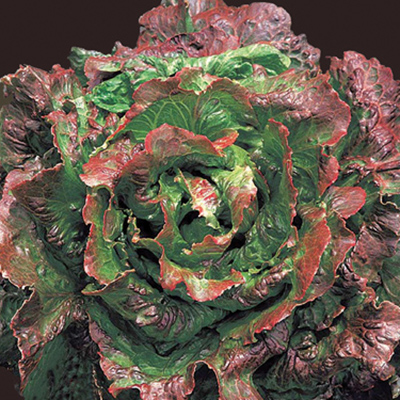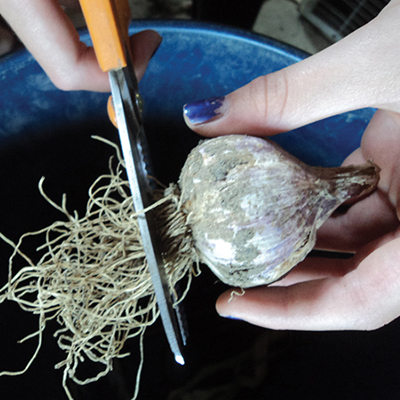I wrote about warm-weather cooking greens in Growing for Market back in April 2007 (Keep the greens coming: Swiss chard and other summer spinach substitutes. I wrote a lot about Swiss chard, leaf beet (perpetual spinach) and beet greens (my favorite summer cooking greens) there, and a short paragraph each about a handful of other cooking greens. Here I am going to write about more cooking greens and next month about salad greens for hot weather. These are not two distinct categories, as many crops can be used both ways.
Chard, Beta vulgaris subsp. vulgaris
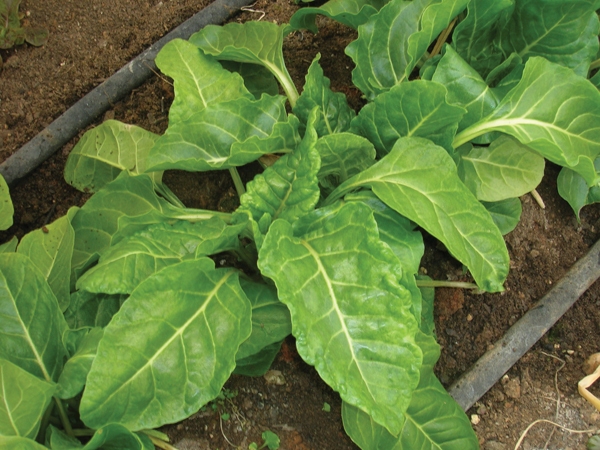
Chard Verde da Taglio from Seeds from Italy can be picked all summer, even in Virginia heat. Photo courtesy of Susan Hill.
Southern Exposure Seed Exchange (SESE) recommends Swiss chard as the very best choice for summer cooking greens in the South. As a biennial, it usually won’t bolt (go to seed) until it has gone through winter. It stays productive, tender and mild all summer. Chard Verde da Taglio (Greens for Cutting in English) from Seeds from Italy has been recommended by my neighboring farmer Susan Hill, who supplied the photo. She says “I grew it all summer for my customers craving spinach and they were thrilled. I picked it at about four to five inches and found the texture and taste excellent.” My own favorite is Perpetual Spinach, Beta vulgaris ssp cicla, definitely a chard, not a true spinach. It has thin stems and green leaves which are small by chard standards. It is easy to grow, either direct-seeded or from transplants. We sow in plug flats 3/24 and plant out 4/22, around our last frost date.
Red Malabar summer spinach, Basella rubra
SESE also strongly recommends Red Malabar summer spinach. The crisp, fleshy, glossy, slightly succulent leaves stay mild andmaintain healthy growth all summer until cut down by the slightest frost. They are excellent for stir-fries or for thickening summer soups and stews (can be slimy if cooked alone). The vine tips (a.k.. Land Kelp) can also be used as cooking greens and the young leaves can be added to salad mixes. The flavor is similar to mild beet greens. William Woys Weaver reports that it cooks beautifully in a microwave, but on a hot day eat the refreshing leaves raw. The leaves store for up to two weeks in the refrigerator. Bees love the blossoms. Pest-free, but watch out for the staining properties of the black berries (good for dying fabric). There is also a green-leaved Malabar spinach with red stems, Basella alba, but the red is exceptionally beautiful, so I recommend that one.
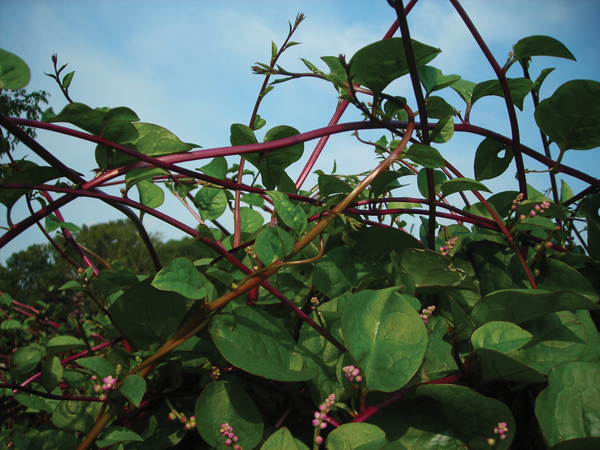
The red twining vines of Red Malabar summer spinach should be trellised to keep the succulent leaves clean. Photo courtesy of Southern Exposure Seed Exchange.
The gorgeous red twining vines are very tall, so they need to be trellised or caged, which has the bonus of keeping the leaves clean. One technique is to plant them on the pea trellises and let them take over as the peas finish. This crop also does well in partial shade. Sow in late spring, when it’s warm enough for beans. (There are 36 seeds per gram.) Germination is slow; even at their preferred temperature of 70-80°F the seeds can take 10-14 days. You could start them indoors and transplant at 3-6 weeks old, or more, as much as 8” tall. Plant or thin to 12-18” apart. The plants need 90 days to maturity, and then will grow all summer. Pinch out the tips when the vines are as tall as you want to deal with. They will regrow even if severely cut back. Malabar spinach does self-sow, but this is only likely to be a problem for those in tropical climates.
New Zealand spinach, Tetragonia tetragonoide or Tetragonia expansa
Young growing tips of this sprawling plant resemble spinach when cooked. Picking the individual triangular leaves would be tedious, as they are fairly small, so go for the shoots. Like true spinach, Tetragonia leaves contain oxalic acid, so should be eaten in moderation, mixed with other greens.
There are about 10 seeds per gram. Seed should be soaked 4-24 hours before planting to speed germination. It can take 8 weeks to germinate. Direct-sow from mid to late spring (bean-planting time), or sow indoors about 6 weeks before last frost and expect 65-75 days to maturity. New Zealand Spinach tolerates heat and drought beautifully, and it is generally free of pests. It can become invasive as it sets seed readily. This happened to me the first year I grew it – I thought some self-sowing would be a good thing, but I seriously under-estimated both the number of seedlings I’d get and the distance the seeds could ping.
Beet tops, Beta vulgaris
I have heard that golden beets were originally grown for their green leaves rather than their roots (red beets were developed for roots). There are certainly varieties of both colors that offer good greens. Bull’s Blood, made famous by Eliot Coleman as a winter hoophouse crop, has dark maroon, almost purple, leaves. You can pick the smaller leaves all season to add color to a salad. Larger leaves are better cooked, more tender and sweeter than chard, though not so tender as spinach. Like chards, beets are biennial, and should not go to seed the first summer. Lutz Green Leaf beets have, as well as those large winter storage roots, large pale green leaves almost as big as chard. MacGregor’s Favorite (aka Dracena ) has elongated, narrow, iridescent leaves that vary from dark red to magenta to purple. They are tender and delicious when cooked. It is possible to lightly harvest leaves and still get good roots, but keeping the same plants alive all summer and removing leaves too frequently will diminish the roots of course, so be clear about your plans.
Purdue University trialed 23 beet varieties for the performance and flavor of roots and tops. Solo, a monogerm red variety (and the highest ranked overall in the trial) and Touchstone Gold had high ratings for appearance and flavor of cooked greens. Merlin, Red Ace, Kestrel, and Detroit Supreme were the best red beets in terms of cooked appearance and flavor for both the roots and greens. Beets are adapted to grow in cool weather, don’t wait until it’s hot to sow them. They make best growth when the days are warm (60° to 70°F) and nights cool (50° to 60°F).
Egyptian Spinach, Corchorus olitorius (Jute leaves)
A.k.a. Molokheiya, Molokhia and similar attempts to render the Arabic name in our alphabet. This versatile, continuous harvest vegetable can survive both dry and wet conditions in warm or hot weather. The fresh leaves can be eaten as a salad green or potherb and dried leaves can be used to thicken soups or for tea. It’s not a vegetable to be eaten alone in big cooked heaps – it’s just too mucilaginous. Otherwise, it can be used anywhere spinach would be used. It grows well in Virginia, North Carolina, Florida, Texas and everywhere with hot summers. It grows 2-3’ tall or more, and then bears yellow flowers if you don’t keep it clipped back. The flowers are followed by seed pods which are edible and tasty when young, with more flavor than the leaves. The mature seeds can be saved for replanting. A blogger in Texas claimed “At 100° plus, it’s just as sweet and tender as springtime lettuce.” Another reported eating the leaves daily from spring to beyond October.
Bountiful Gardens reassures buyers that the seed is naturally green in color and is not treated. Depending on your climate and preferences, you can direct sow fairly heavily and thin, or start seeds in flats and transplant 12” apart in all directions. Plant out after danger of frost is past and soil is warming steadily. Egyptian Spinach likes full sun, warm to hot weather and steady moisture - mulch will help keep soil moist. Continue to give compost or nutrients throughout the season, to keep it making tender growth. It takes 70 days to maturity, then holds well in the field and several cuttings are possible. If you prefer to harvest the whole plant, succession-sow for future supplies. http://en.wikipedia.org/wiki/Mulukhiyah
Vegetable amaranth, Amaranthus species
In spring use the young leaves for salad. Larger leaves make tender and nutritious cooked greens. Calaloo is an amaranth (but sometimes other crops have this name), used to make a green Caribbean stew. Joseph’s Coat, Amaranthus tricolor, is an eye-catching plant with red, green, and yellow leaves that may also include patches of pink, bronze, purple and brown. This tropical plant thrives in really hot weather. It is a huge plant, 4-6’ tall. Carol Deppe in The Tao of Vegetable Gardening recommends All Red for a spectacularly colorful leaf, especially for salads, and Green Calaloo and Burgundy for fast-growing greens. She reports they all taste the same to her raw, and all taste the same when cooked. So choose by preferred color and rate of growth.
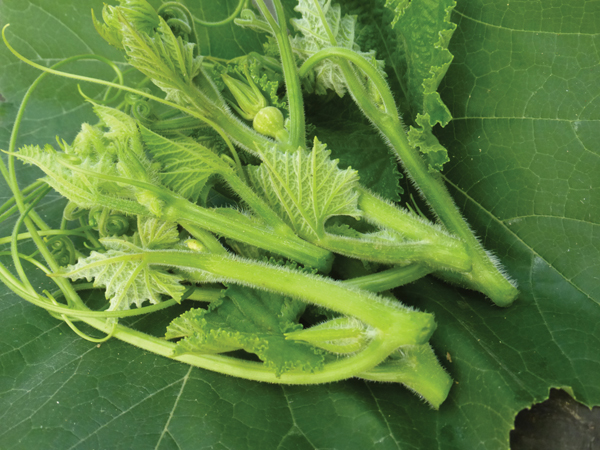
Seeds should be started indoors in spring, and transplanted once all chance of frost has passed, when it is time to plant corn. Alternatively, broadcast with aim of getting plants 4” apart. Each time the plants reach 12” tall, harvest the top 8”. Pinch back often to push out new leaves and prevent reseeding (it can become a weed problem). If your farm has lots of amaranth weeds, you won’t want to risk adding another. Also, if weed amaranths are eaten by the striped fleabeetles, your cultivated amaranths will also suffer. (Those are the two reasons we gave up on them.)
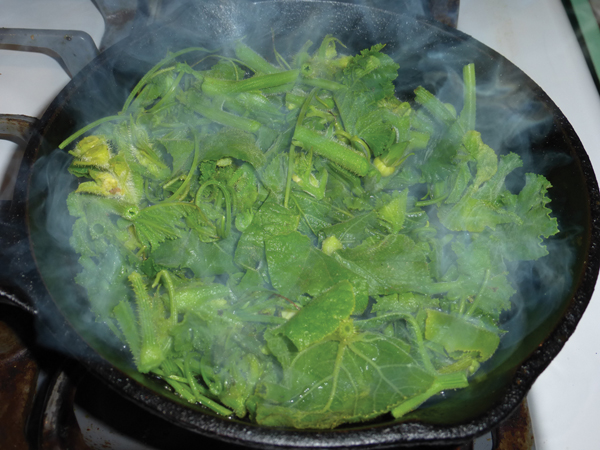
Squash vine tips, called tenerumi in Italy, can be sauteed like any other green. Photos courtesy of SESE.
William Woys Weaver is a fan of ‘Bliton’ or ‘Horsetooth Amaranth’, Amaranthus lividus (Amaranthus viridis). He reports that it is the easiest and most prolific of summer greens. Seed should be started indoors, except in the South. Transplant seedlings when it’s warm enough to plant beans (Frequent advice for many of these hot weather greens). Alternatively, broadcast where it is to grow after all danger of frost is past. Thin the seedlings for salads or harvest plants about 12” tall and cook like spinach. When the plant is older, the stems get too tough, and then only the leaves and new shoots should be used. In parts of the South, it has become a weed – “Grow responsibly,” as Barbara Pleasant says in her Mother Earth News blogpost Warm Weather Spinach Alternatives.
Aztec Spinach, Huauzontle, (Chenopodium berlandieri)
This chenopodium (goosefoot), has bigger leaves, more tender stems and better resistance to bolting than common lambsquarters. Broadcast and thin to 4” apart, harvest young leaves for salad just 30 days after sowing. Grow to 12” tall, then harvest the top 8”. This could be less than 8 weeks from sowing, depending on your climate. After the first harvest, thin the plants to 12” apart, and the bushy new growth will provide leaves for future harvests. Later, the budding flowers are cooked for breakfast. Wrap the stems with buds around a soft white chees, dip the whole thing in batter and then fry the fritters, and simmer in a chile sauce. This may be more a springtime dish than a summer one, depending when the plants start to flower. Succession-sowing in summer may be the solution to providing a later crop. There is also a red version – the lower leaves turn bright red as they mature, and stay red when cooked (a mere 30-60 seconds in boiling water).
Water Spinach, Ipomoea aquatica; aka Kang Kong, Ong Choy, Phak Bung
This tropical, semi-aquatic plant is cultivated as a vegetable for its tender shoots and leaves. It is easy to start from seed or you can root cuttings (roots show in 2-3 days) from bunches bought at an Asian supermarket. The long stems will readily root from the nodes. The leaves are quite large: 2-6” by 1-3”. It is still classed as a USDA Class A noxious weed in Hawaii, Florida and California, where it has escaped into the wild. Check your state regulations, and grow this in some sort of containers to be sure. The tender shoots are cooked along with the leaves. The flowers look just like sweet potato flowers.
Sweet Potato Leaves, Ipomoea batatas
A safer bet is to eat sweet potato greens instead. Plant sweet potatoes for a fall root harvest, and get the extra greens crop all summer! You can harvest the leaves and young shoots for cooking greens at any time during growth (just don’t take too much at once). For cooking ideas, find Water Spinach recipes and substitute sweet potato shoots. Chile and shrimp feature in many recipes, or peanut sauce (more Southern!)
Squash leaves and shoots, Cucurbita spp.
Any time your squash are being too rambunctious, or you are thinning a row a bit late and have sizeable plants, consider a harvest of vine tips and leaves. Or grow some just for this purpose, if you need a quick-growing summer green with novelty appeal. Stir-fry or gently braise – good with eggs for breakfast, says Ira Wallace.
Blackeye peas and other crowder peas: The tips and leaves are edible.
Edible Celosia, Celosia argentea
Celosia, the popular cut flower, comes from tropical Africa, where the fresh young leaves are used in a dish of various vegetable greens, combined with onion, hot peppers, eggplant, vegetable oil, and fish or meat. Peanut butter may be added as a thickener. The ingredients are boiled together into a tasty and nutritious soup. Ira Wallace at SESE reports that in their trial it didn’t suffer from a single pest attack.
“The variety that I grew last summer was called ‘Sokoyokoto,’ the plant’s name in southern Nigeria’s Yoruba language,” she said. “I got it from an African grad student who said that it also grows wild in Nigeria.
“An article in the Lost Crops of Africa indicates that all Celosia argentea varieties are edible.
“We also ate leaves from ‘Star Trek’ celosia which tasted good. We plan on trialing more traditional edible varieties this summer to see if we can distinguish differences.”
Pam Dawling manages 3.5 acres of vegetable gardens at Twin Oaks Community in central Virginia. Her book, Sustainable Market Farming: Intensive Vegetable Production on a Few Acres, is widely available, including at www.sustainablemarketfarming.com, or by mail order from Sustainable Market Farming, 138 Twin Oaks Road, Louisa, Virginia 23093. Enclose a check (payable to Twin Oaks) for $40.45 including shipping. Pam’s blog is on her website and also on facebook.com/SustainableMarketFarming

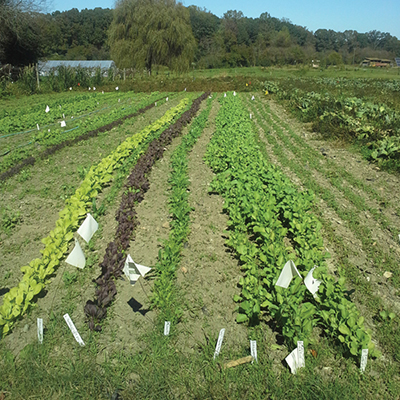
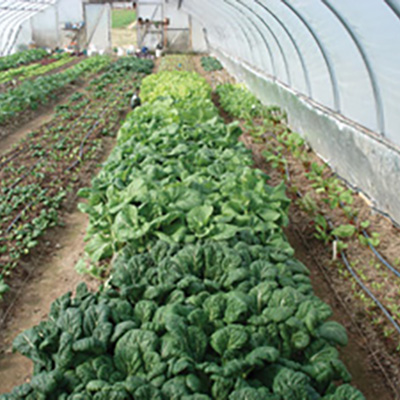
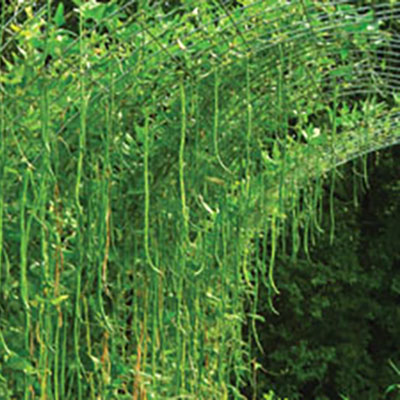

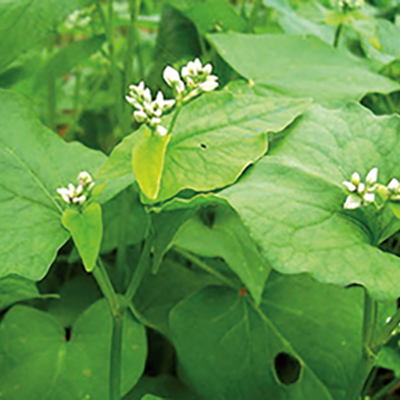
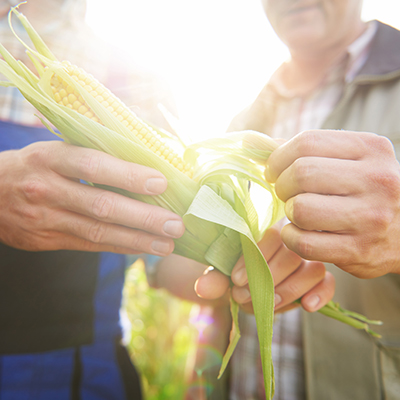

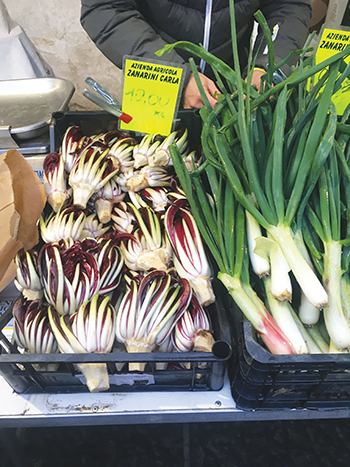 Plan now for a crop from stored roots next winter
Plan now for a crop from stored roots next winter
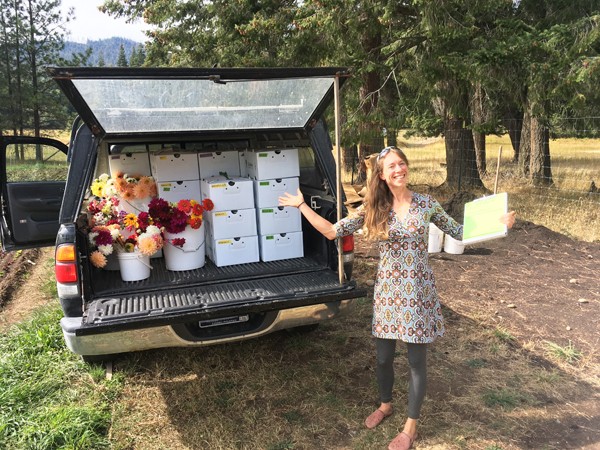 To get right to the point, one of my goals as a farmer, and as a person who wants to do something useful with her life, is to make the local, sustainably produced food that we all sell normal. By that, I mean available where the vast majority of Americans shop: grocery stores. As I see it, polished, professional products and service that sells itself is the most direct way to that goal.
To get right to the point, one of my goals as a farmer, and as a person who wants to do something useful with her life, is to make the local, sustainably produced food that we all sell normal. By that, I mean available where the vast majority of Americans shop: grocery stores. As I see it, polished, professional products and service that sells itself is the most direct way to that goal. 
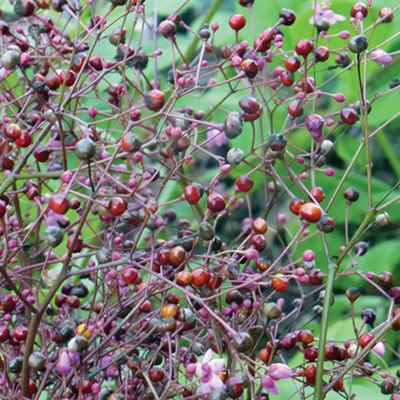


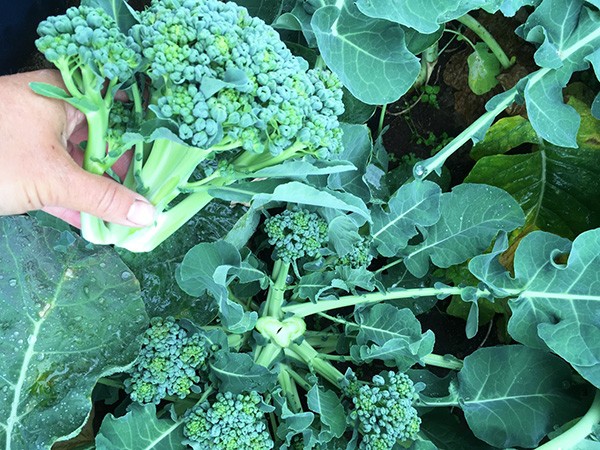 It took me years to find, but I finally have a favorite broccoli. I’m actually not a fan of the standard hybrid types; I don’t love their flavor, they take up a lot of space for just one harvest, and ubiquitous as they are, I’m limited in what I can charge for them. So I kept trying all the open-pollinated and non-heading types until I hit on one that I love: Piracicaba.
It took me years to find, but I finally have a favorite broccoli. I’m actually not a fan of the standard hybrid types; I don’t love their flavor, they take up a lot of space for just one harvest, and ubiquitous as they are, I’m limited in what I can charge for them. So I kept trying all the open-pollinated and non-heading types until I hit on one that I love: Piracicaba.